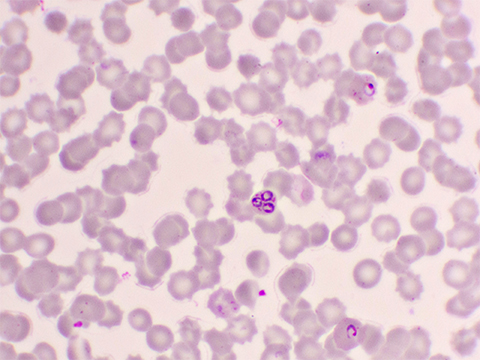From the journals: JBC
Prefoldins participate in parasite pathology. Protein modifications coordinate in DNA repair. Nucleotide analog blocks viral RNA polymerases. Read about papers on these topics recently published in the Journal of Biological Chemistry.
Prefoldins participate in parasite pathology

The World Health Organization estimated that malaria infections exceeded 200 million in 2022. Malaria is caused by the protozoan parasite Plasmodium falciparum. Treatment involves artemisinin-based combination therapy, which integrates a derivative of the drug artemisinin with one or more additional drugs with diverse modes of action. Scientists are searching for alternative forms of treatment because certain strains of P. falciparum have developed resistance to artemisinin. A previous study showed that resistant strains overexpressed genes involved in the unfolded protein response pathway, one of which encodes a prefoldin protein, a cochaperone. Researchers are still working to understand how the prefoldin family contributes to protein homeostasis and connects to broader mechanisms of parasite resistance.
Rumaisha Shoaib, Nidha Parveen and Vikash Kumar from Jawaharlal Nehru University and an international team characterized all prefoldin subunits from P. falciparum and recently published their findings in the Journal of Biological Chemistry. They performed immunoprecipitation and mass spectrometry analyses and found that prefoldin interacts with the Plasmodium protein Kelch13, which may act as an adapter protein for ubiquitination and degradation. Mutations in this protein have been linked to artemisinin resistance.
Furthermore, the researchers wanted to determine if inhibiting a prefoldin complex would affect resistant parasite growth. They screened a library of Food and Drug Administration–approved drugs and found that biperiden, mainly used to treat Parkinson’s disease, can inhibit prefoldin subunit interactions. They treated both an artemisinin-sensitive and artemisinin-resistant strain of P. falciparum with biperiden and determined that the compound inhibited growth in both cases. Biperiden also disrupted prefoldin interactions with the cytoskeletal protein α-tubulin-I and the merozoite surface protein MSP-1, which are involved in parasitic invasion. These results pinpoint prefoldins as a potentially valuable target when studying drug-resistant malaria parasites and highlight biperiden as a possible antimalaria candidate worth further investigation.
Protein modifications coordinate in DNA repair
Two main pathways fix double-strand DNA breaks, nonhomologous end-joining and homologous repair, with DNA damage response factors involved in pathway selection. Both pathways recruit multiple factors to the damaged site in tightly regulated processes critical for genome maintenance, and posttranslational modifications play a major role in coordinating these events. For example, scientists know that E3 ubiquitin ligases add ubiquitin to target molecules, such as histones, but only if the target has already been modified with adenosine diphosphate–ribose, or ADP-ribose, by a poly ADP-ribose polymerase, or PARP. Researchers are working to uncover which E3 ligases are involved in these pathways.
In a recent paper from the Journal of Biological Chemistry, Billel Djerir from the Université de Sherbrooke in Canada and a team of international scientists performed a localization screen and identified seven E3 ligases involved in the DNA damage response. The researchers focused follow-up studies on one ligase, the DELTEX RING E3 family member, or DTX2, and found that its recruitment to sites of DNA damage depends on PARP. Additionally, depleting DTX2 dampens homologous recombination efficiency. However, this deletion moderately enhanced the nonhomologous end-joining pathway. The authors speculated that DTX2 could fine-tune the DNA damage response and affect which repair pathway operates. Next, scientists will need to identify specific substrates of DTX2 and determine how its ubiquitylation activity mechanistically drives repair pathway regulation.
Nucleotide analog blocks viral RNA polymerases
Respiratory RNA viruses can spread easily, making drug discovery a priority for managing outbreaks. Scientists face challenges in targeting these viruses due to their diversity, but a common therapeutic mechanism involves inhibiting the viral RNA polymerase to shut down replication. These polymerases have a relatively conserved active site, making it possible to develop broad-spectrum antivirals. Nucleotide analogs are inhibitors that can outcompete the substrate for RNA polymerase chain extension. The first Food and Drug Administration–approved treatment for COVID-19, remdesivir, is a nucleotide analog containing a C-adenosine and a cyano group attached to the sugar ring’s first carbon.
In a study from the Journal of Biological Chemistry, Calvin Gordon and colleagues at the University of Alberta and Gilead Sciences compared the activity of a recently discovered nucleotide analog containing the cyano group on the sugar ring’s fourth carbon, GS-646939, against purified RNA polymerases from prototypic respiratory RNA viruses. They found that GS-646939 caused immediate chain termination and was effective at inhibiting polymerases from pneumoviruses and picornaviruses, although it displayed varying activity against RNA polymerases from additional respiratory RNA viruses. The authors rationalized the selectivity based on structural modeling of the cyano group’s position in the active sites. They noted that other bulky fourth carbon modifications have also been found to cause chain termination, indicating that scientists may want to pursue these types of nucleotide variants for drug development against emerging viruses.
Enjoy reading ASBMB Today?
Become a member to receive the print edition four times a year and the digital edition monthly.
Learn moreGet the latest from ASBMB Today
Enter your email address, and we’ll send you a weekly email with recent articles, interviews and more.
Latest in Science
Science highlights or most popular articles

Using DNA barcodes to capture local biodiversity
Undergraduate at the University of California, Santa Barbara, leads citizen science initiative to engage the public in DNA barcoding to catalog local biodiversity, fostering community involvement in science.

Targeting Toxoplasma parasites and their protein accomplices
Researchers identify that a Toxoplasma gondii enzyme drives parasite's survival. Read more about this recent study from the Journal of Lipid Research.

Scavenger protein receptor aids the transport of lipoproteins
Scientists elucidated how two major splice variants of scavenger receptors affect cellular localization in endothelial cells. Read more about this recent study from the Journal of Lipid Research.

Fat cells are a culprit in osteoporosis
Scientists reveal that lipid transfer from bone marrow adipocytes to osteoblasts impairs bone formation by downregulating osteogenic proteins and inducing ferroptosis. Read more about this recent study from the Journal of Lipid Research.

Unraveling oncogenesis: What makes cancer tick?
Learn about the ASBMB 2025 symposium on oncogenic hubs: chromatin regulatory and transcriptional complexes in cancer.

Exploring lipid metabolism: A journey through time and innovation
Recent lipid metabolism research has unveiled critical insights into lipid–protein interactions, offering potential therapeutic targets for metabolic and neurodegenerative diseases. Check out the latest in lipid science at the ASBMB annual meeting.

